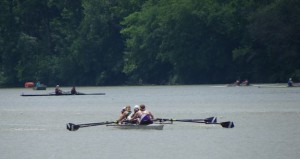Unlike most sports, rowing is done facing backwards. Although larger boats have a coxswain whose job it is to look ahead and steer, people who row smaller boats just have to turn and look every once in a while. Turning to see what is in front of the boat reduces a rower’s speed; so it’s best just to take occasional quick glances, while being careful to stay on a good course and not run into obstacles.
There’s also the current to consider—when rowing upstream, struggling against the current can slow down the boat quite a lot, so staying closer to shore where the current is not as strong may be the best option. But when the water level is low and the current is sluggish, it may be quicker to row in a more direct line up the middle of the river.
Experienced rowers who are familiar with the river can manage all of this with no trouble; but it’s much harder on a new course, and for those who are just learning. Sometimes I’ve thought that life feels like rowing upstream in an unfamiliar place. Although too much worry about possible obstacles ahead slows us down, we can’t spend all our time looking at what is behind us, either.
We may stop and explore a small side channel for a while, but then it becomes too narrow, and we have to turn around and continue up the river. All those small channels fall away behind us, lost in the trees, the memories forever in the past. Whatever emotions they hold are free to float away down the channel, to be filtered and purified in the wetlands and eventually flow into the sea. Only the lessons learned from those experiences remain, as guidance in finding the best course going forward.

